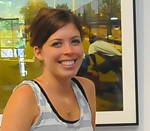The Intersection of Public Art and City Planning

Meredith Frazier Britt

Meredith Frazier Britt


What a great week filled with aspirations and reflections from emerging leaders in the public art field!
Thank you to all of our bloggers who made this salon a success by sharing their thoughts and inspiration for their thoughts and inspirations on their careers and the future of the public art field.
Reading these posts throughout the week has given light to some of the great talent that will be guiding the future of public art. We heard from Kati Stegall reflecting on how we can keep up with the changes happening throughout the country and from Meredith Frazier Britt, an up-and-coming city planner who is eager to work with public art (we need more of her!)
Read More

 Alex White-Mazzarella
Alex White-Mazzarella
It was about six years ago, in 2007, sitting in my small Hong Kong apartment, that I put down ideas for a work practice that would use public art and modern culture as means of developing community and habitat. A practice where the arts would be used not just as an aesthetic to beautify or to activate space, but as productions of communality with the residents of a place and through a process that would open a space for community members to develop and connect. It came from contact with arts in public spaces.
Read More

 Felipe Sanchez
Felipe Sanchez
By 2008, the world-renowned murals of Los Angeles metaphorically had a nail in their coffin; they had become a faded memory in the consciousness of the city. This amnesia of preserving the cultural patrimony of LA was a social epidemic that I later learned was happening to public art in many cities across the country. Mural after mural along the LA’s freeways and neighborhoods were disappeared and abandoned by the city – scenes so appalling that I set out to find organizations that could shed some light on the issue. Little did I know this small but significant action would set the stage for the next phase of my career in the arts.
Read More

 Jennifer Lieu
Jennifer Lieu
I walked away with three things upon finishing my graduate studies in Public Art and Urban Planning: a diploma and two questions. How can I help make art that is more accessible intellectually, emotionally and physically? What are alternative and sustainable income resources for artists to make a living besides selling art in galleries and trying to find work as a tenured art professor? These questions follow me to every informational interview I participate in and panel discussion I attend. I continually think about them.
These questions shaped how I was going to accomplish my goals and led to my interest in public art. I identified that I want to help artists produce artwork that people can relate to, and would be willing to see without feeling like they have to be dragged into a museum. I also want to help connect artists with alternative resources for income and skill growth. When discussing these goals with my peers and mentors, I have been encouraged to learn more about public art. Now that I am working in the field, I find that these goals continuously resonate with me and inform questions about my future in public art.
Read More

 Jennifer Lantzas
Jennifer Lantzas
I am a firm believer that you have to understand where you have been to know where you are going—and public art in NYC has changed drastically over the past century and a half. The first sculpture in a New York City park was George Washington by Henry Kirk Brown, which was unveiled in Union Square in 1856. For the next 100 years public artworks were predominantly commemorative or memorial in nature—realistic representations of notable politicians, soldiers, and leaders.
By the 1960s, new ideas about what constituted artwork freed artists to explore new forms of materials and exhibitions. Sculpture grew beyond the constraints of studio and gallery spaces, and people embraced the social and political impact of art. With big sculptures, big ideas, and performance artists’ impromptu “happenings” in the City’s public spaces, it was only natural that visual artists wanted to bring their artwork outdoors.
Read More



Arts organizers face a unique set of problems, probably similar to that of a circus ringleader. You need diplomacy, imagination, creativity, flexibility. You also have to be incredibly practical - managing budgets, funders, logistics. You’re often working with volunteers and supporters who need to receive non-economic benefits and feel engaged and excited. Communication is key.
First, what is “the field” we’re talking about? Artist-run spaces, experimental venues, artists creating platforms and opportunities for other artists, and organizations that put supporting artists’ work at the heart and center of their mission. We operate across a wide range of organizing principles - from being a 501(c)3 organization to a co-operative or collective, from long-running institutions to short-term projects - but we all struggle with a similar set of questions. Why is supporting experimental visual art practice important? Who are our audiences and partners? What are our tactics and strategies? What does sustainability look like? How can articulate more broadly the values and impacts emerging from this work?
Read More

 Barrie Cline
Barrie Cline
Some years back, I was fortunate enough to be asked to develop an arts course for the mainly rank and file construction workers that are required by their union to attend our Labor College. I chose to develop a class on public art seeing it as a vehicle to take up issues around working class studies by initially focusing on the built environment of New York City, thinking that engagement might be sought as my (sometimes reluctant) students were builders of that environment.
The emphasis on NYC’s built environment in Tom Finkelpearl’s text Dialogues in Public Art proved one way to introduce this study, as well as to take up issues of representation and to open up what art can be and whom it can be for. At some point, it became obvious that the class actually should allow for making art, particularly after incorporatingreadings from Larry Shiner’s The Invention of Art which helped us look at the possible re-elevation of the construction tradesperson’s own artisanship, given Shiner’s argument that Fine Art is a relatively recent construct of the west in the eighteenth century. We began to think about work as art, and about making their labor—and the worker—more visible.
Read More

 Cameron Russell
Cameron Russell
It often strikes me that pundits and political scientists are engaged in a very limited discussion about politics. I am bored hearing about the political elite and about the influence of money. I think people that have been considered politically marginalized often illuminate sites of equality and of hope. Their stories of effecting change from the margins are especially relevant as an increasing majority of Americans find themselves marginalized from our political and economic systems.
My first encounter with public art was reading Jack Stewart’s book Graffiti Kings. At its height, during the 1970s, Stewart wrote, “Few urban communities had ever experienced such a rapid and concentrated alteration of their visual environment.” An alteration accomplished largely by 8 to 16 year old Black and Latino boys. Why was the demographic least likely to vote, or engage in organizational work, in control of one of the fastest visual changes of an urban environment?
Read More

 Meredith Frazier Britt
Meredith Frazier Britt
I am a city planner who can’t stay away from public art. I just finished my capstone project for my master’s in city and regional planning at Georgia Tech, and true to form, I studied commonalities between public art and planning goals in the Atlanta region.
My interest in public art began with art history in college. I trace it to a flashbulb memory of a beloved professor snapping to a slide of Claes Oldenburg’s imagined (but never constructed) intersection-blocking monument in New York City. I loved that this piece would so fully obstruct the activity of city life, interrupting our regular routes of walking and driving, imposing its message on our thoughts.
Read More

What do you think of when you hear the words, “public art?” A figurative bronze sculpture of a local hero or historical figure? Perhaps a large, brightly painted, abstract steel sculpture on your local University campus? Maybe even a landscape painting that hangs in the lobby of City Hall behind Plexiglas?
Well, here are some things that might not immediately spring to mind:


One thing I can say for sure is that every day for the last ten years I have had tea and toast for breakfast. In spite of that, I have managed to fashion a unique career in Arts Administration that has been far from stale. In December, I even mixed up my bread choices and after over a decade as a program coordinator and media manager at New Mexico Arts, I joined the City of Santa Fe Arts Commissionas Program Planner,and took my first shot of the real espresso that is public art.
So while I have worked in arts administration for many years, I am a newbie to Public Art. I should preface this to say that over the years I have dipped my toe in the public art pool and have always been aware of engaging public art on the periphery of my vision through the innovative TIME (Temporary Installations Made for the Environment) program presented by New Mexico Arts. I marketed and sent out press releases and attended wonderful openings and met phenomenal artists, but I had never been a part of the actual bricks and mortar of public art, it was just something I flirted with. I visited but never moved in. I had an understanding that calls for artists were issued, selection processes took place, and artists were selected for projects, but then it was like “voila” - a commission was installed and I encountered these beautiful works in public spaces with commissions that were thoughtfully incorporated into the unique architecture of the place. It was still just tea with a touch of milk.
Read More

The way I think through and solve problems is different. Good, but different, apparently. My contribution to boardroom meetings and planning sessions is either over heads or under the table. What does that mean? It really boils down to whether or not I am in a position to work through each element of an idea and illustrate how the idea attempts to solve the problem at hand, or if I propose an idea using general terms that avoid the mechanics of implementation. Maybe the best way to describe this ever-occurring event is through example.
A little over a year ago I sat in the basement of city hall, eagerly awaiting my turn to propose an idea for how the public art commission that I had recently joined could better engage the community. I suggested providing public art updates and information through various social media channels like Twitter and Facebook. I spent the next 15 minutes describing what a “tweet” was and how the “hashtag” or “pound” symbol could be used to virtually catalog and archive content. That suggestion was over many of my fellow commissioners’ heads. Had I simply suggested that we “explore alternative forms of communication to connect with members of the community,” I might have received a few smiles and nods in agreement and the next person would have been able to proceed with their suggestion. That would have been an under the table approach – a stealthy way of gauging support for a Twitter or Instagram account without having to spend time explaining what they are and how they work.
Read More

My path to becoming an arts administrator is a tad unorthodox. My advanced degree is in social policy analysis and my previous professional experience is that of a public health researcher. In fact, I’m not sure I identify solely as an arts administrator. Or a policy analyst. Or a public health researcher. Instead, the world I inhabit is that of someone passionate about connecting with individuals and communities, in a tangible and meaningful way, to help address the deeply entrenched health-related challenges they face every day. Threaded throughout my winding journey to the City of Philadelphia Mural Arts Program is a core belief that we all live within a layered reality – one defined by our individual traits and behavior, our social relationships to friends, family, and neighbors, our living and working conditions including the physical environment around us, and the economic, political, and social policies and systems that impact us locally, nationally, and globally. The ecosystem in which we all interact and navigate is complex and impacts our health in very real ways. The extent to which each layer of our reality hinders and supports us as we strive for well-being varies for each of us.
Read More

What central ideas are today’s emerging public art leaders organizing around? What accomplishments will last, and how are we working collectively to better our field?
Every field has some organizing ideas or principles, and public art is no exception. From the outset of posing these questions, however, it must be said that relative newcomers to the field, like me, have benefitted enormously from the achievements of earlier leaders. Beginning with the widespread adoption of percent for art policies and ordinances at the local, state and national levels; to the fuller integration of artists and art in the design process; and the growth of public art in transit and private development projects, these successes have made dialogues like this possible.
Read More

My path to a career in public art was not by personal design. I moved to New York City to get discovered as a performer and live the dream I had cultivated since birth (or at least since seeing Jennifer Holliday sing on the Tony Awards.) There were a few steps in that strategic plan that I had not taken into account, like surviving in New York City. I needed a survival job.
As an actor, I found a home with a children's theater company, and paid my bills as an Executive Assistant. During the week I worked for the Dean of Columbia Business School, where I studied how he dealt with a Board and a staff, while on the weekends I was a beast, a mermaid king, a rocking horse, or a giant.
As the years and survival jobs passed, I began to realize that the arts field was much broader than I had realized. It offered many meaningful opportunities to engage with all types of audiences beyond the stage.
Read More

Nationwide, it is no longer a question of whether or not the field of public art is going to change. It is more appropriate now to ask why the changes are happening and how can we keep up. Many of the changes observed and documented in Norie Sato’s blog from May, Is Public Art Dead?, are happening all over the country, including here in Charlotte. They are happening because we are reaching a point in the development of the field where there are some very specific “shifts” or transitions happening: in leadership, in program priorities, and also in communities themselves.
Leadership shifts are not easy to talk about, but the fact is in some cases the leaders who paved the way for public art for the last 30 - 40 years are retiring or moving on to other opportunities, leaving us with new leadership. This brings both advantages and disadvantages. There will be an experience gap, as new leaders emerging in public art have not experienced first-hand what former leaders have. But they also are approaching the challenges with an innate set of skills in technology and communication that is necessary to keep up in today’s world where information is everywhere. The biggest advantage we have at this point is the impact that these leaders and their work had on legislation, funding, and the general respect of artists and their art. They have laid a foundation that we need respect and take advantage of to move the field forward.
Read More

As Norie Sato asked in her “Is Public Art Dead?” blog back in May, “Public art as we know it […]is getting to be more than 40 years old. Programs are celebrating 30, 40, 50 years of existence. It is no longer a new thought, no longer exciting in its promise, reach and approach…or is it?”
Throughout her blog post she contemplates some of the trends that have been plaguing the field as it has developed over the past half century. This week during the Emerging Leaders in Public Art Administration Blog Salon we will hear from the next generation of public art administrators who are eager to move the field forward in the next evolution of public art as we continue onward into the 21st Century.
Read More